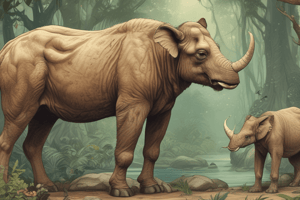Podcast
Questions and Answers
What is a defining feature of vertebrates?
What is a defining feature of vertebrates?
- Presence of fins
- Possession of a backbone (correct)
- Lack of a backbone
- External skeleton
Which group is NOT included in vertebrates?
Which group is NOT included in vertebrates?
- Fish
- Mammals
- Amphibians
- Insects (correct)
What role do invertebrates play in ecosystems?
What role do invertebrates play in ecosystems?
- Limited to parasitic roles
- Majority of vertebrate species
- Only found in marine environments
- Crucial roles in food webs (correct)
What is a primary cause of species decline mentioned in conservation biology?
What is a primary cause of species decline mentioned in conservation biology?
What unique adaptation do mammals possess?
What unique adaptation do mammals possess?
What is the branch of biology that studies animals called?
What is the branch of biology that studies animals called?
Which major animal phylum includes sponges?
Which major animal phylum includes sponges?
How are evolutionary relationships among animals commonly illustrated?
How are evolutionary relationships among animals commonly illustrated?
What do anatomical features of animals often reflect?
What do anatomical features of animals often reflect?
Which of the following is a study of animal behavior?
Which of the following is a study of animal behavior?
What is investigated in animal ecology?
What is investigated in animal ecology?
What concept is crucial for understanding animal evolution?
What concept is crucial for understanding animal evolution?
Behavioral adaptations in animals are primarily shaped by which process?
Behavioral adaptations in animals are primarily shaped by which process?
Flashcards
Zoology
Zoology
The branch of biology focusing on the study of animals, encompassing their anatomy, physiology, behavior, evolution, and interactions with their environment.
Animal Diversity
Animal Diversity
The incredible variety of forms, functions, and behaviors observed in animals.
Taxonomic Classifications
Taxonomic Classifications
The scientific classification system used to organize and categorize animals based on shared characteristics, including kingdom, phylum, class, order, family, genus, and species.
Phylogenetic Trees
Phylogenetic Trees
Signup and view all the flashcards
Animal Anatomy
Animal Anatomy
Signup and view all the flashcards
Animal Physiology
Animal Physiology
Signup and view all the flashcards
Animal Behavior (Ethology)
Animal Behavior (Ethology)
Signup and view all the flashcards
Animal Ecology
Animal Ecology
Signup and view all the flashcards
Natural Selection
Natural Selection
Signup and view all the flashcards
Invertebrate Zoology
Invertebrate Zoology
Signup and view all the flashcards
Vertebrate Zoology
Vertebrate Zoology
Signup and view all the flashcards
Conservation Biology
Conservation Biology
Signup and view all the flashcards
Threats to Animal Populations
Threats to Animal Populations
Signup and view all the flashcards
Study Notes
Introduction to Zoology
- Zoology is the scientific study of animals.
- It encompasses various areas, including anatomy, physiology, behavior, evolution, and ecology.
- Zoologists study animal diversity, from tiny invertebrates to large mammals.
- Their work helps us understand animal evolution, behavior, and their roles in ecosystems.
Animal Diversity
- Animals show remarkable variety in form, function, and behavior.
- Their diversity is classified using a taxonomic system, including kingdom Animalia, phylum, class, order, family, genus, and species.
- Major animal phyla include Porifera (sponges), Cnidaria (jellyfish, corals), Platyhelminthes (flatworms), Annelida (segmented worms), Mollusca (snails, clams, squids), Arthropoda (insects, crustaceans, spiders), Echinodermata (sea stars, urchins), and Chordata (vertebrates).
- Phylogenetic trees illustrate the evolutionary relationships between animals by showing branching patterns of shared ancestry.
Animal Anatomy and Physiology
- Animal anatomy describes the structure of an animal's body.
- Animal physiology investigates the functions within an animal's body.
- Anatomy and physiology are closely linked; structures often relate to their function, showing adaptations and evolutionary histories.
Animal Behavior
- Animal behavior (ethology) studies how animals interact with their surroundings and each other.
- Behavioral studies include foraging strategies, mating, communication, and parenting.
- Behavioral adaptations are crucial for survival and influenced by natural selection.
Animal Ecology
- Animal ecology studies the relationships between animals and their environments.
- Key concepts include population dynamics, community interactions, and ecological roles.
- Animals are impacted by factors like climate, resources, and interactions with other species.
Animal Evolution
- Animal evolution examines the descent of animals from ancestral forms.
- Phylogenetic relationships reflect shared ancestry.
- Common ancestry and adaptation are fundamental to understanding animal evolutionary history.
- Natural selection has shaped animal traits and behaviors.
- Fossil records and genetic analyses help us understand past animal life.
Vertebrate Zoology
- Vertebrates, a major animal group (subphylum Chordata), have a backbone and internal skeleton.
- Vertebrate groups include fish, amphibians, reptiles, birds, and mammals.
- Mammals have unique adaptations like mammary glands for nursing their young.
Invertebrate Zoology
- Invertebrate zoology studies animals without backbones, a vast portion of animal diversity.
- This includes insects, crustaceans, mollusks, and more.
- Invertebrates have diverse adaptations for survival in various environments.
- Many play vital roles in food webs.
Conservation Biology and Zoology
- Conservation biology uses ecological, evolutionary, and behavioral principles to protect animal populations.
- Human activities, like habitat loss, threaten species survival.
- Conservation efforts aim to safeguard endangered species and habitats.
- Zoology provides vital biological data for effective conservation strategies.
Studying That Suits You
Use AI to generate personalized quizzes and flashcards to suit your learning preferences.



